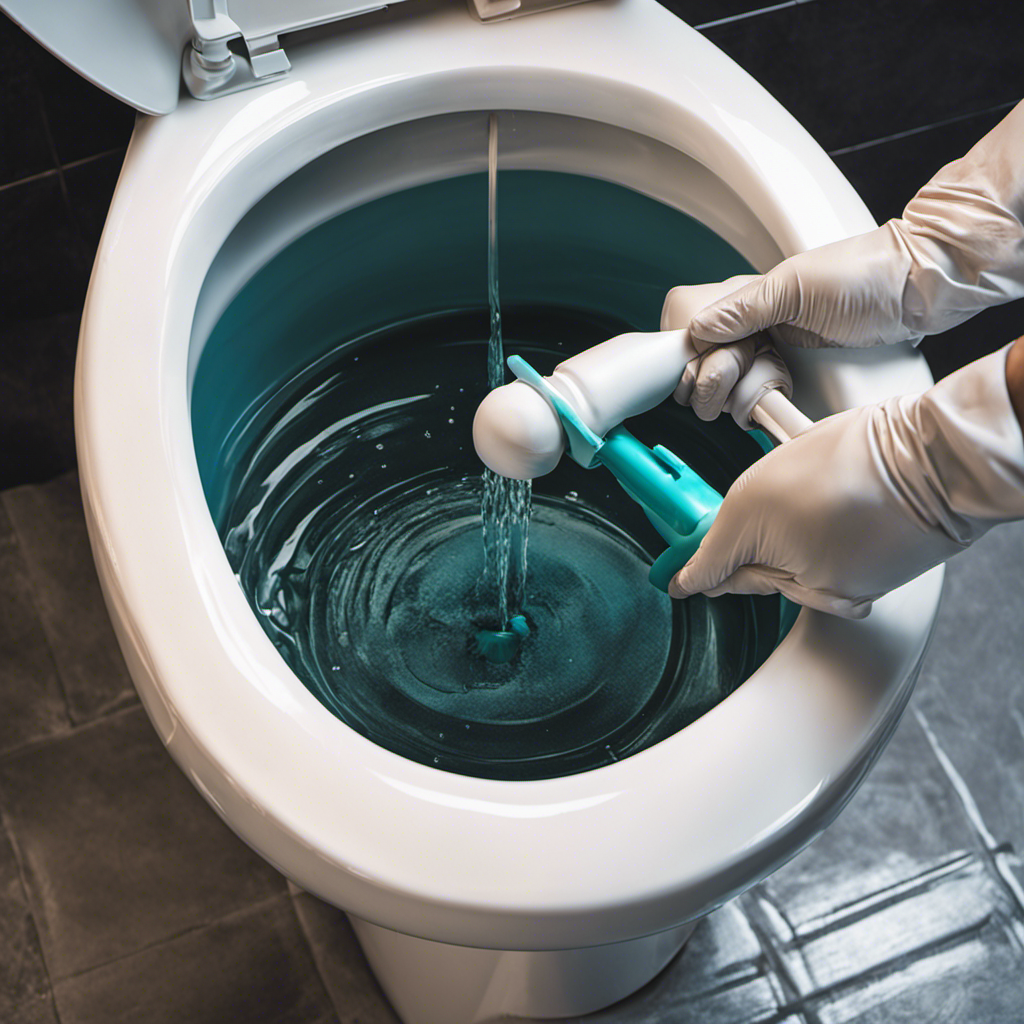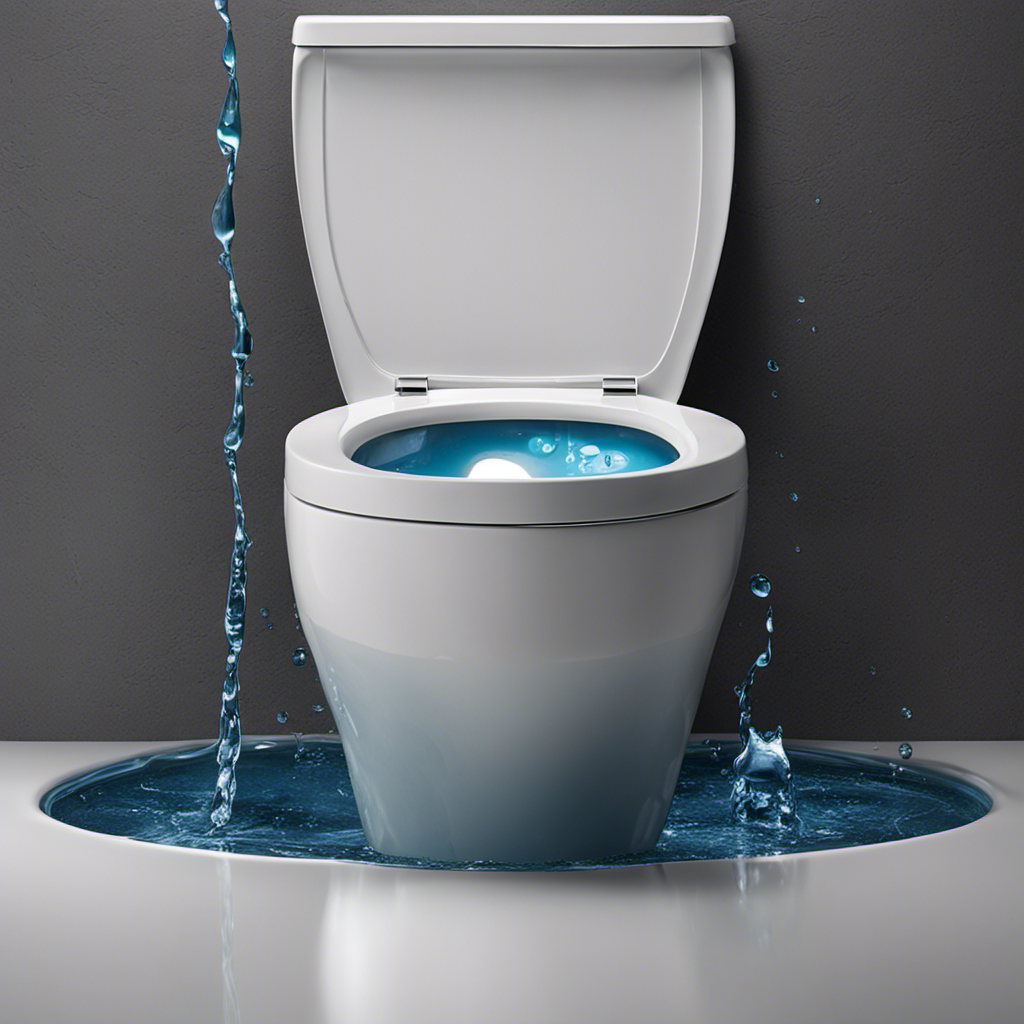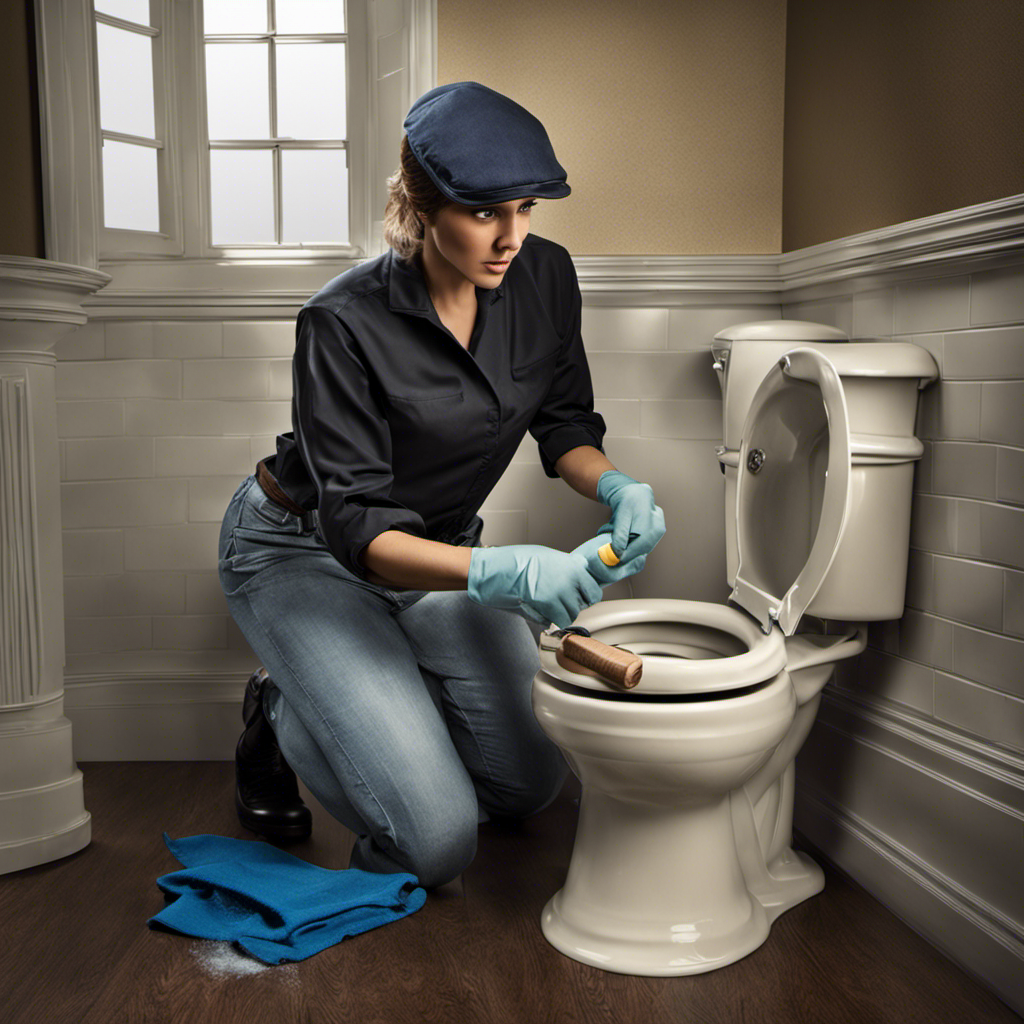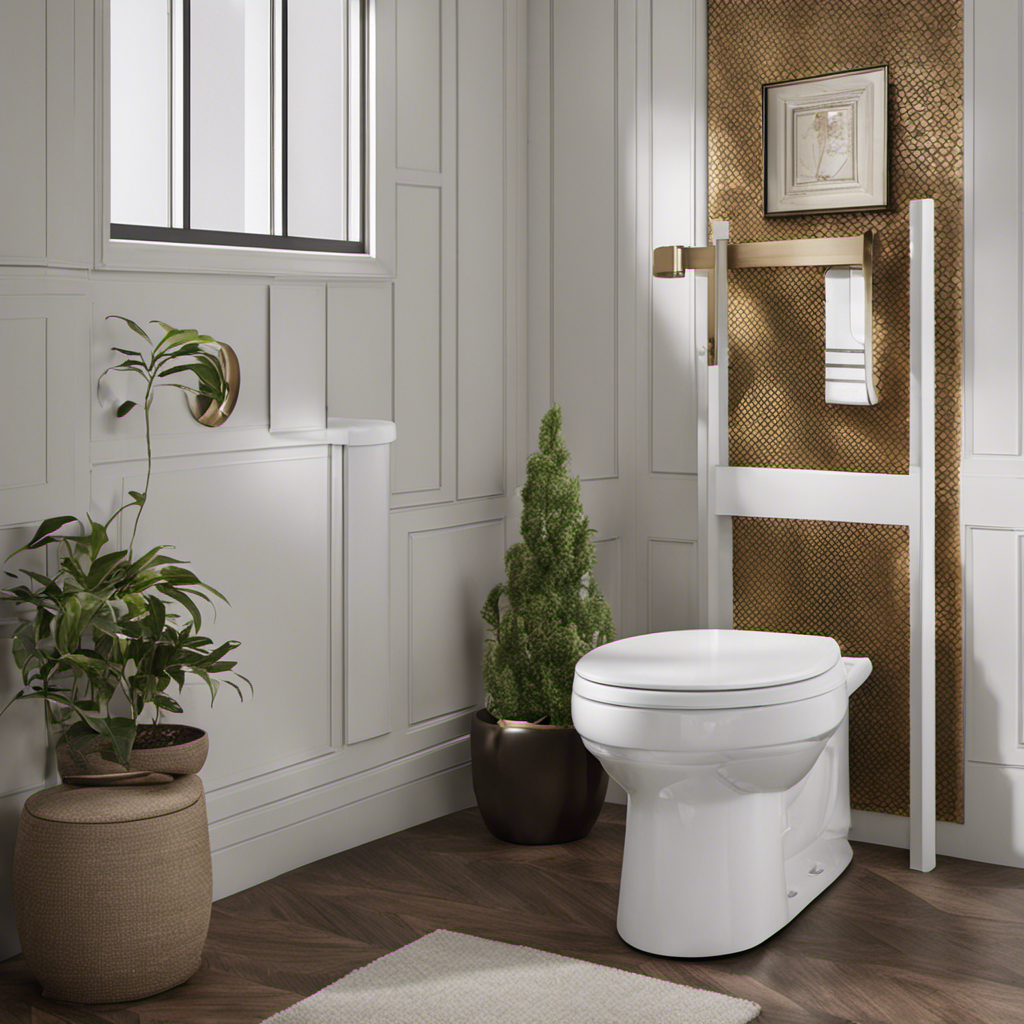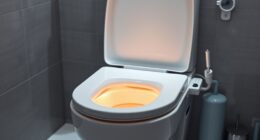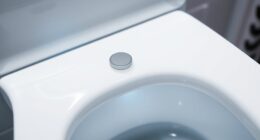I’ve been there before – standing in front of a clogged toilet, feeling frustrated and unsure of what to do next. But fear not, because in this article, I’ll guide you through the steps to fix your clogged toilet like a pro.
From identifying common causes to using the right tools, I’ll provide you with a detailed and informative guide to unclogging your toilet.
So, let’s get started and say goodbye to those pesky toilet clogs once and for all!
Key Takeaways
- Flushing excessive amounts of toilet paper and non-flushable items can cause toilet clogs.
- Regular maintenance with a toilet brush and mindful flushing practices can help prevent clogs.
- Using hot water, baking soda and vinegar, or a plunger can effectively unclog a toilet.
- Natural remedies such as baking soda and vinegar can be used to prevent future toilet clogs.
Common Causes of a Clogged Toilet
One of the most common causes of a clogged toilet is flushing too much toilet paper at once. When we use excessive amounts of toilet paper, it can easily get stuck in the pipes, leading to a blockage.
To prevent clogs, it’s important to be mindful of the amount of toilet paper we flush. A good practice is to only use a reasonable amount and flush in small increments.
Another common cause of a clogged toilet is flushing non-flushable items, such as sanitary products, baby wipes, or paper towels. These items are not designed to break down in water and can cause serious blockages.
To avoid this, it’s essential to only flush toilet paper and waste.
Tools and Materials You’ll Need
When dealing with a clogged toilet, it’s important to have the right tools and materials on hand to effectively tackle the problem.
One essential tool for unclogging is a plunger, which creates pressure to dislodge the blockage.
Additionally, you’ll need a pair of rubber gloves to protect your hands from any potential mess.
Essential Tools for Unclogging
You’ll need a plunger and a plumbing snake to unclog a toilet. These essential tools are a must-have for any homeowner.
Here are some other items that can come in handy when dealing with a clogged toilet:
- Rubber gloves: Protect your hands from any potential mess.
- Bucket: Useful for removing excess water from the toilet bowl.
- Hot water: Pouring hot water into the toilet can help break up the clog.
- Baking soda and vinegar: This natural solution can be an effective alternative to harsh chemicals.
- Toilet auger: A specialized tool designed to tackle stubborn clogs.
By following these tips and using the right tools, you can prevent toilet clogs and easily fix them when they occur.
Now, let’s move on to the next section, where we’ll discuss the types of materials needed for unclogging a toilet.
Types of Materials Needed
The types of materials you’ll need include a plunger, a plumbing snake, rubber gloves, a bucket, hot water, baking soda, vinegar, and a toilet auger. These tools are essential for tackling toilet clogs and ensuring a smooth-running bathroom. Let’s take a look at each material and its purpose:
| Material | Purpose |
|---|---|
| Plunger | Creates suction to dislodge clogs |
| Plumbing snake | Removes stubborn blockages |
| Rubber gloves | Protects your hands from germs and debris |
| Bucket | Collects water and waste during the unclogging process |
| Hot water | Helps break down waste and clear the clog |
| Baking soda | Natural cleaner and odor neutralizer |
| Vinegar | Reacts with baking soda to create a fizzy cleaning solution |
| Toilet auger | Used for more severe or persistent clogs |
Step-by-Step Guide to Unclogging a Toilet
To unclog a toilet, start by using a plunger to create pressure and dislodge the blockage.
Here are some DIY toilet unclogging techniques and tips for preventing future clogs:
- Proper Flushing: Avoid flushing large amounts of toilet paper or non-flushable items at once.
- Regular Maintenance: Use a toilet brush to clean the inside of the bowl regularly, preventing buildup.
- Hot Water and Dish Soap: Pouring a mixture of hot water and dish soap into the toilet bowl can help break down clogs.
- Baking Soda and Vinegar: Mix equal parts of baking soda and vinegar, pour it into the toilet, and let it sit for a while before flushing.
- Plumber’s Snake: If the plunger doesn’t work, try using a plumber’s snake to physically remove the blockage.
Now that you know some prevention techniques, let’s move on to how to use a plunger effectively.
How to Use a Plunger Effectively
Now that you know the step-by-step guide to unclogging a toilet, let’s focus on one of the most effective methods: using a plunger.
When faced with a clogged toilet, the plunger technique can often be your best friend. To start, make sure you have a good-quality plunger with a flange, as this will create a better seal.
Position the plunger over the drain hole and press it down firmly, ensuring a tight seal. Then, push and pull the plunger vigorously, creating suction to dislodge the clog. Repeat this process several times, but be careful not to overflow the toilet.
If you find that the plunger technique doesn’t work, there are alternative methods you can try, such as using a plumbing snake or a mixture of baking soda and vinegar.
Using a Toilet Auger to Clear the Blockage
Using a toilet auger can be a highly effective method for clearing a blockage in the drain. It’s a simple tool that can save you from the hassle of a clogged toilet. However, if you don’t have a toilet auger or are looking for alternatives, there are other methods you can try.
Here are some troubleshooting tips for using a toilet auger:
- Check the length of the auger: Make sure it’s long enough to reach the blockage.
- Insert the auger into the toilet bowl: Gently push the auger into the drain, rotating it as you go.
- Apply pressure: Once the auger is inserted, apply downward pressure to break up the blockage.
- Rotate the auger: Continue rotating the auger to grab onto the blockage and pull it out.
- Flush the toilet: Finally, flush the toilet to ensure the blockage is completely cleared.
Natural Remedies to Try Before Calling a Plumber
If you’re experiencing a blockage in your drain, you might want to consider trying natural remedies before calling a plumber. There are several DIY solutions that can help clear a clogged toilet without the need for harsh chemicals or expensive equipment.
One option is to use a mixture of baking soda and vinegar. Start by pouring half a cup of baking soda into the toilet bowl, followed by a cup of vinegar. Let the mixture sit for about 30 minutes, then flush with hot water.
Another natural remedy is using a toilet plunger. Make sure there is enough water in the bowl to cover the rubber end of the plunger, then plunge vigorously to create pressure and dislodge the blockage.
These natural remedies can often solve minor clogs, but if the problem persists, it’s best to call a professional plumber.
To prevent future toilet clogs, it’s important to be mindful of what you flush down the toilet. Avoid flushing items like baby wipes, cotton balls, and feminine hygiene products, as they can easily cause blockages. Additionally, consider installing a drain strainer or screen in your toilet to catch any debris that could potentially clog the pipes.
Regular maintenance, such as using a toilet brush to clean the bowl and flushing with hot water, can also help prevent buildup and keep your toilet running smoothly. By taking these preventive measures, you can minimize the chances of encountering future toilet clogs and save yourself the hassle of dealing with a blocked drain.
Preventing Future Toilet Clogs
When it comes to preventing future toilet clogs, there are a few key points to keep in mind.
First, it’s important to use proper flushing techniques, such as holding down the handle until all waste has been flushed away.
Regular maintenance is also crucial, which includes checking for any signs of leaks or blockages and addressing them promptly.
Lastly, avoiding excessive toilet paper can significantly reduce the risk of clogs, so it’s essential to use only the necessary amount and to dispose of it properly.
Proper Flushing Techniques
To properly flush the toilet, make sure you press down the handle all the way. Proper flushing techniques are essential to prevent clogs and ensure efficient operation of your toilet. Here are some tips to help you flush your toilet effectively:
- Apply firm pressure: Press down on the handle firmly to activate the flushing mechanism.
- Use enough water: The proper amount of water is crucial for a thorough flush. Ensure that the tank is filled to the recommended level.
- Wait for the flush to complete: Allow the water to flow fully into the bowl before releasing the handle.
- Check water pressure: Adequate water pressure is necessary for a strong flush. If you notice low water pressure, consider contacting a plumber to address the issue.
- Regular maintenance: Keep your toilet in good working condition by regularly cleaning and inspecting the flush mechanism.
Regular Maintenance Tips
Regular maintenance is important for keeping your toilet in good working condition. By following these regular maintenance tips, you can prevent future clogs and ensure a smoothly functioning toilet.
First, make sure to clean the toilet bowl regularly using a non-abrasive cleaner. This will help remove any buildup or debris that could potentially lead to a clog.
Additionally, it’s important to check the flapper valve and flush handle periodically to ensure they are functioning properly. If you notice any issues, such as a weak flush or continuous running, make the necessary repairs or replacements.
Finally, be mindful of what you flush down the toilet. Avoid flushing excessive amounts of toilet paper or non-flushable items, as they can easily cause clogs.
Avoiding Excessive Toilet Paper
By using less toilet paper, you can prevent excessive clogs in your toilet. Here are some simple alternatives and tips to help reduce your toilet paper usage:
- Bidet attachment: Install a bidet attachment to your toilet to clean yourself with water instead of using toilet paper.
- Wet wipes: Consider using wet wipes specifically designed for flushable use. However, be cautious as some wet wipes may not break down easily in the sewage system.
- Cloth wipes: Use reusable cloth wipes that can be washed and reused. This is an eco-friendly option that reduces waste.
- Reduce layers: Try using fewer layers of toilet paper per use. You may find that you don’t need as much as you think.
- Use recycled toilet paper: Opt for toilet paper made from recycled materials to minimize environmental impact.
Conclusion
In conclusion, tackling a clogged toilet may seem daunting at first, but with the right tools and techniques, it can be resolved quickly and easily.
Just like unclogging a toilet, facing life’s challenges requires patience, determination, and the right approach.
By following the step-by-step guide and utilizing natural remedies, you can effectively clear the blockage and prevent future clogs.
Remember, just as a plunger plunges through the obstacles, you too can conquer any obstacle that comes your way.
